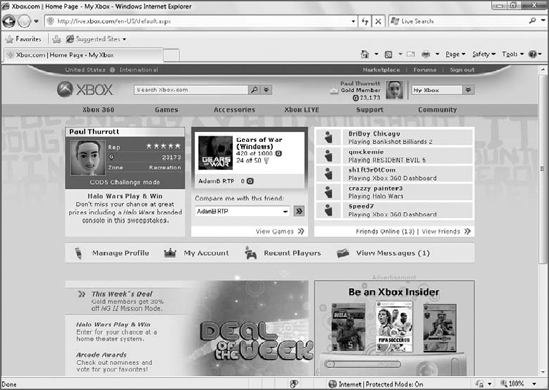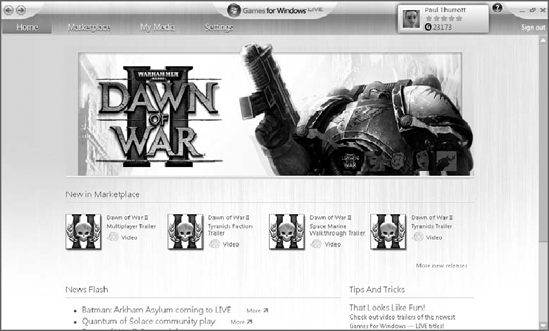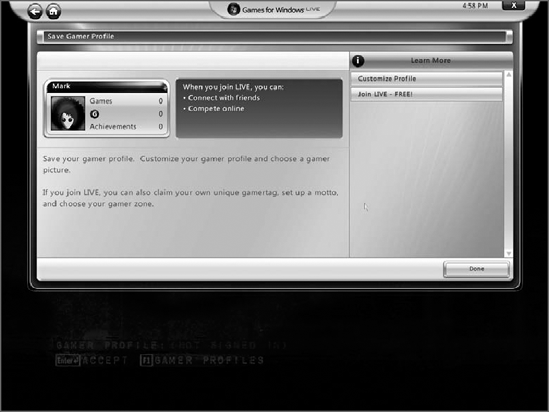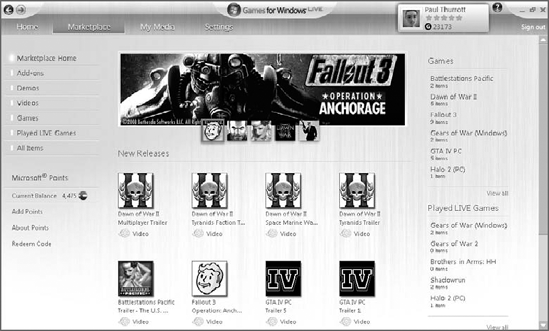Separate from its PC gaming initiatives, Microsoft
has been promoting its line of Xbox video game consoles since 2001. In
late 2005, the company significantly raised the bar with the release of
its second-generation Xbox 360 console, featuring unparalleled graphics
power and connectivity, and ushering in a new era of high-definition
(HD) video gaming. In some ways, the biggest leap forward that
Microsoft made with the Xbox 360, however, was the massive set of
improvements it made to the system's online service, Xbox Live. This
service provides a way for Xbox 360-based gamers to face off in
multiplayer matches, of course, but it also offers movie and TV show
downloads, instant messaging functionality, and other features. It's
the most full-featured online service for any video game console, by
far.
Xbox Live has been so successful that is has colored
how the company approaches other similar online endeavors. In the years
since the launch of the Xbox 360, Microsoft has used its successes with
Xbox Live as a model for such things as the Zune Marketplace, an online
service that supports Microsoft's digital media players and, more recently, a new initiative called Games for Windows - LIVE.
Games for Windows - LIVE is an attempt to replicate
the success of Xbox Live on the PC and, to a much lesser extent, to
provide interconnectivity between Windows-based gamers and Xbox
360-based gamers. Since it is both modeled on and tied directly to Xbox
Live, it should come as no surprise that Games for Windows - LIVE is
very much like Xbox Live from a user experience perspective. That said,
Games for Windows - LIVE is still lacking some key Xbox live features.
It also has some troubling problems that suggest it will never really
take off in the same way that Xbox Live has on Microsoft's consoles.
Here's what's happening.
1. Xbox Live on Windows?
Xbox Live customers each have a Gamertag, which is associated with a Windows Live ID. This Gamertag includes a reputation (or Rep,
scored from one to five stars), a Gamerscore (the total number of
Achievement points collected in all the Xbox 360 games the gamer has
played), and other data. You can see this information on the Xbox.com Web site, shown in Figure 1.

Gamers also can access the list of games they've
played, with Achievements broken down by game. (You can of course
access other players' Gamertags as well, to compare and contrast
experiences or to find potential foes online.) Each Gamertag has
associated lists of messages (similar to e-mails), friends (like
contacts), and players (other gamers they've faced off against online).
Also included are various settings, related to game types, the
Dashboard, and other aspects of the Xbox 360 experience.
NOTE
It sounds like Microsoft has created a
full-fledged e-mail and instant messaging system here, doesn't it? Sure
enough, that's exactly what the communications-oriented parts of Xbox
Live—and, by extension, Games for Windows - LIVE—provide. You can even
do voice and video chat over the service. There's just one thing: all
of this communication has to occur over Microsoft's network or, in the
case of the e-mail-type messages, on the Web. You can't, for example,
access Xbox Live messages via a Windows e-mail application such as
Windows Live Mail or an IM solution such as Windows Live Messenger. And
that's odd, when you think about it, since the underlying services used
by these applications can access e-mail and instant messages sent to
the same associated Windows Live ID you may use for gaming. Maybe
someday.
The reason the Xbox Live Gamertag system works so
well on the Xbox 360 is that Microsoft has made the underlying Xbox
Live service so thoroughly integrated across the system. If you're in a
game of Call of Duty World at War or watching a live or recorded TV show via the Xbox 360's Media Center Extender functionality , your friends can see what you're up to, even if they're playing Gears of War 2 or just browsing the downloadable content on Xbox Live Marketplace, Microsoft's online store.
The trick is bringing this experience to Windows
users. Here, Microsoft has been fairly successful. After an initial
tepid release, newer versions of Games for Windows - LIVE feature a
decent in-game experience and the start of an online marketplace of
sorts that may someday be pretty useful.
2. The Games for Windows - LIVE Experience
Games for Windows - LIVE is available in two places
in Windows. The first is a stand-alone Windows application, Games for
Windows - LIVE Marketplace, which is shown in Figure 2.
From this simple but almost useless Dashboard-like UI, you can log on
to your Windows Live ID—and thus your Gamertag—but you can't view or
update any useful gamer information about that account, as you can from
the Xbox 360 Dashboard. Instead, this UI is designed solely to provide
access to a fledgling online marketplace.

|
From what we can see, only two useful bits of
information are available in this interface: your Gamertag, Rep, and
Achievement points totals are viewable in the upper-right corner; and
on the Marketplace tab, you can see how many Microsoft Points—for
making micropayments—are available in your account. That's about it.
|
|
The second place is an in-game Dashboard that
appears only in Games for Windows - LIVE game titles and works much
like the pop-up interface that Xbox 360 gamers see. From this
interface, you can view and edit your Gamertag and associated Windows
Live ID account, view information about the games you've played, access
your Friends list, read and send messages, and engage in private chats.
This interface is shown in Figure 3.

What you can't do from the Dashboard is access the
marketplace: that interaction has to occur via the standalone client
application.
2.1. Using the Games for Windows - LIVE Marketplace
The standalone Games for Windows - LIVE client is
single-handedly devoted to the new Games for Windows – LIVE
Marketplace, which is an online service and store that provides free
and paid game-related content. This content spans the range from game
videos and demos to add-on content that you can install into your
existing Games for Windows - LIVE games. It's all pretty sparse at this
point, and certainly nothing like the similar Xbox Marketplace
experience on the Xbox 360. In fact, before you can even access this
service, you have to create a Gamertag, and that has to happen on the
Web: you can't do it from within the Games for Windows - LIVE
standalone client.
That said, it's not a complete loss: in addition to
downloading game demos from Games for Windows - LIVE, you can also
install these demos from directly in the client. That's handy; though
once those game demos are installed, you can't actually run them from
Games for Windows - LIVE. Instead, you have to navigate into the Games
Explorer or the Start menu to find them.
To browse the marketplace, open the Games for
Windows - LIVE client (here, Start Menu Search is your friend, since
this application is not automatically added to the Games Explorer for
some reason). Then, navigate to the Marketplace tab, shown in Figure 4. From here, you can browse game add-ons, demos, videos, games, and other related content.

Some items, like game demos, are free. Others, like
some game add-ons, require a fee. As with Xbox Live, you pay for items
on the Games for Windows - LIVE Marketplace using Microsoft Points, the
software giant's micropayment system.
NOTE
Why can't Microsoft simply use local currency
like all other online merchants? That's a fair question, and when
pressed, Microsoft says the reason is that it would incur a credit card
fee on every transaction, even those that were for small amounts of
money, thus making local currency transactions prohibitively expensive.
With Microsoft Points, you buy points in bulk in amounts like $25 or
$50, saving Microsoft money. Of course, the problem with this system is
that you often have leftover points that you can't redeem. Did we
mention that this was like a free loan to Microsoft, the largest
software company on earth? Yeah, it really is.
Microsoft Points do have one redeeming quality,
assuming you've bought into the broader Microsoft ecosystem: they work
across several services, including Xbox Live, Zune Marketplace, and the
Games for Windows - LIVE Marketplace. As a result, you could load up
your account with points and purchase an Xbox Live Arcade game on Xbox
Live, a Games for Windows - LIVE game title add-on from Games for
Windows - LIVE Marketplace, and a digital version of the new U2 album,
all in the same day, all using the same account.
Purchased Microsoft Points are associated with your
Windows Live ID and, thus, with your Xbox Live Gamertag, your Zune
profile, and your Games for Windows - LIVE Gamertag. You can purchase
Microsoft Points in various ways, including via the Microsoft Points
Web site (http://points.microsoft.com)
and with prepaid Xbox Live and Zune Marketplace points cards (found
near the register in electronics superstores like Best Buy). If you do
need to add points, the Games for Windows - LIVE standalone application
has a link, Add Points, that redirects you to the Microsoft Points Web
site. Using the client, you can also redeem points using a prepaid
card, using the 25-character code it contains.
Beyond this tepid step into e-commerce, the Games
for Windows - LIVE client doesn't have much to offer currently. That
could change in the future, but for now the real action occurs when
you're using an actual Games for Windows - LIVE game title.